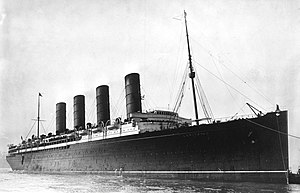Historical Flavor: The Sinking of the Lusitania

Part of being a writer is research. Part of being a historical writer is going back in time to find those little tidbits that make a story interesting and factual.
Shows like Downton Abbey have revived an interest in the early years of the 20th century, particularly the World War I era. Added to that was last year’s 100-year anniversary of the sinking of the Titanic. I remember learning about the ill-fated ship as a child.
But I also learned about the sinking of the Lusitania, and for some reason, that one truly stuck in my mind. What I didn’t know, or didn’t remember, was the mystery surrounding the sinking—one that is still being explored today.
The Lusitania was a British passenger ship of the Cunard line, the sister ship of the Mauritania, and had its maiden voyage in September of 1907. On May 1, 1915, it left New York on its way to Liverpool with 1,959 people on board—159 of them Americans.
Its last day came a week later, on May 7, when it was struck by a torpedo from a German u-boat eight miles off Ireland’s coast. It sank in eighteen minutes. The death toll was 1,198—128 Americans. An especially sad note: there were 35 infants on board. All but four perished.
Due to the German u-boats that terrorized the Atlantic during World War I, ships’ captains were instructed to travel at the highest rates of speeds possible and zigzag their way through the water, always on the lookout for submarines.
Two explosions rocked the ship that day, and some survivors said they saw more than one submarine. The Germans claimed they fired only one torpedo and that the ship carried munitions—the suspected source of the second explosion—and that made it a legitimate military target. For years the British (as well as the American) government denied knowing anything about war materials being on board, but the captain and other naval experts said one torpedo would not have sunk the ship without it striking explosive materials.
In 2008, Gregg Bemis, an American who owns the rights to the shipwreck, financed an exploration of the Lusitania that discovered almost 4 million rounds of .303 Remington bullets (U. S. made). An April 30, 2013 article in the Irish Times referred to a possible future exploration by Mr. Bemis, who wants to discover what else might have been on board that ship that could have contributed to its rapid sinking.
So the question remains: Were the excessive amounts of butter, lard, and cheese on the manifest really butter, lard, and cheese?
This is just an overview of the sinking of the Lusitania, but it’s these mysteries of the past that make researching novel settings so interesting.
Whether you’re a writer or not, what event in history stands out to you, and have you discovered something fascinating about it that you hadn’t realized before?
You can find more information at websites like www.lusitania.net.
No Comments
Dora Hiers
How sad! And just when we’re considering booking another cruise.
You sparked my interest, Sandy. Me, the one who only digested historical facts long enough to pass the test. 🙂
Sandra Ardoin
The Germans warned them about transporting munitions on passenger ships, Dora, and they did it anyway–or so it seems. Maybe you should check the cargo hold before you allow the ship to leave port. 🙂